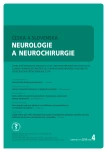Neurological Syndromes Associated with Antibodies against Neuronal Surface Antigens
Authors:
M. Elišák 1; D. Krýsl 1,2; J. Hanzalová 1,3; I. Gažová 1; I. Doležalová 4,5; J. Slonková 6; P. Marusič 1
Authors‘ workplace:
Neurologická klinika 2. LF UK a FN Motol, Praha
1; Klinisk Neurofysiologi, Sahlgrenska Universitetssjukhuset, Göteborg, Švédsko
2; Ústav imunologie, 2. LF UK a FN Motol, Praha
3; Centrum pro epilepsie Brno, I. neurologická klinika LF MU a FN u sv. Anny v Brně
4; CEITEC – Středoevropský technologický institut, MU, Brno
5; Neurologická klinika LF OU a FN Ostrava
6
Published in:
Cesk Slov Neurol N 2015; 78/111(4): 453-458
Category:
Short Communication
doi:
https://doi.org/10.14735/amcsnn2015453
Overview
Background:
Neuronal surface antibodies are associated with numerous neurological symptoms. Better knowledge of these symptoms may improve identification of potential candidates for immunotherapy.
Aim:
Characterize clinical signs in patients with neuronal surface antibodies positivity.
Methods:
We detected neuronal surface antibodies in 11/2011–12/2013 in 224 patients (224 in serum and 37 in cerebrospinal fluid). We investigated anti-NMDAR, anti-AMPAR1, anti-AMPAR2, anti-GABABR, anti-LGI1, anti-CASPR2 using cell-based assays for indirect immunofluorescence (Euroimmun AG). We retrospectively analyzed clinical characteristics of patients with positive neuronal surface antibodies in serum or cerebrospinal fluid other than anti-NMDAR positive patients.
Results:
Neuronal surface antibodies were detected in 11 patients (seven males, median age 58). Six patients had anti-LGI1, four anti-CASPR2 and two anti-AMPAR1 antibodies (one patient had both anti-CASPR2 and anti-AMPAR1 antibodies). Clinical symptoms included chronic epilepsy (n = 5), acute encephalopathy (n = 5) accompanied by epileptic seizures in four patients and one patient presented with cerebellar syndrome and cognitive deficit. Two patients had coincidence of paraneoplastic antibodies (anti-Hu, anti-Ma2). Tumor (small cell lung carcinoma) was diagnosed in one patient (anti-AMPAR1). Eight patients improved following immunotherapy (corticosteroids, IVIG). Early immunotherapy was associated with better outcome.
Conclusion:
NS-Abs were mostly associated with limbic encephalitis and chronic temporal lobe epilepsy. Immunotherapy had better effect when applied early in the disease course.
Key words:
autoimmune diseases – encephalitis – antibodies to cell-surface proteins – limbic encephalitis
The authors declare they have no potential conflicts of interest concerning drugs, products, or services used in the study.
The Editorial Board declares that the manuscript met the ICMJE “uniform requirements” for biomedical papers.
Sources
1. Hughes EG, Peng X, Gleichman AJ, Lai M, Zhou L, Tsou Ret al. Cellular and synaptic mechanisms of anti‑NMDA receptor encephalitis. J Neurosci 2010; 30(17): 5866 – 5875. doi: 10.1523/ JNEUROSCI.0167 ‑ 10.2010.
2. Lalic T, Pettingill P, Vincent A, Capogna M. Human limbic encephalitis serum enhances hippocampal mossy fiber ‑ CA3 pyramidal cell synaptic transmission. Epilepsia 2011; 52(1): 121 – 131. doi: 10.1111/ j.1528 ‑ 1167.2010.02756.x.
3. Krysl D, Elisak M. Autoimunitní encefalitidy. Cesk Slov Neurol N 2015; 78/ 111(1): 7 – 23. doi: 10.14735/ amcsnn20157.
4. Lilleker JB, Jones MS, Mohanraj R. VGKC complex antibodies in epilepsy: diagnostic yield and therapeutic implications. Seizure 2013; 22(9): 776 – 779. doi: 10.1016/ j.seizure.2013.06.004.
5. Brenner T, Sills GJ, Hart Y, Howell S, Waters P, Brodie MJ et al. Prevalence of neurologic autoantibodies in cohorts of patients with new and established epilepsy. Epilepsia 2013; 54(6): 1028 – 1035. doi: 10.1111/ epi.12127.
6. Ekizoglu E, Tuzun E, Woodhall M, Lang B, Jacobson L, Icoz S et al. Investigation of neuronal autoantibodies in two different focal epilepsy syndromes. Epilepsia 2014; 55(3): 414 – 422. doi: 10.1111/ epi.12528.
7. Zandi MS, Irani SR, Lang B, Waters P, Jones PB, McKenna P et al. Disease ‑ relevant autoantibodies in first episode schizophrenia. J Neurol 2011; 258(4): 686 – 688. doi: 10.1007/ s00415 ‑ 010 ‑ 5788 ‑ 9.
8. Cornelius JR, Pittock SJ, McKeon A, Lennon VA, Aston PA, Josephs KA et al. Sleep manifestations of voltage ‑ gated potassium channel complex autoimmunity. Arch Neurol 2011; 68(6): 733 – 738. doi: 10.1001/ archneurol.2011.106.
9. Paterson RW, Zandi MS, Armstrong R, Vincent A,Schott JM. Clinical relevance of positive voltage ‑ gated potassium channel (VGKC) – complex antibodies: experience from a tertiary referral centre. J Neurol Neurosurg Psychiatry 2014; 85(6): 625 – 630. doi: 10.1136/ jnnp ‑ 2013 ‑ 305218.
10. Vincent A, Buckley C, Schott JM, Baker I, Dewar BK, Detert N et al. Potassium channel antibody‑associated encephalopathy: a potentially immunotherapy ‑ responsive form of limbic encephalitis. Brain 2004; 127(3): 701 – 712.
11. Gresa ‑ Arribas N, Titulaer MJ, Torrents A, Aguilar E, McCracken L, Leypoldt F et al. Antibody titres at diagnosis and during follow‑up of anti‑NMDA receptor encephalitis: a retrospective study. Lancet Neurol 2014; 13(2): 167 – 177. doi: 10.1016/ S1474 ‑ 4422(13)70282 ‑ 5.
12. Bien CG, Urbach H, Schramm J, Soeder BM, Becker AJ, Voltz R et al. Limbic encephalitis as a precipitating event in adult ‑ onset temporal lobe epilepsy. Neurology 2007; 69(12): 1236 – 1244.
13. Gabilondo I, Saiz A, Galán L, González V, Jadraque R, Sabater L et al. Analysis of relapses in anti‑NMDAR encephalitis. Neurology 2011; 77(10): 996 – 999. doi: 10.1212/ WNL.0b013e31822cfc6b.
14. Irani SR, Stagg CJ, Schott JM, Rosenthal CR, Schneider SA, Pettingill P et al. Faciobrachial dystonic seizures: the influence of immunotherapy on seizure control and prevention of cognitive impairment in a broadening phenotype. Brain 2013; 136(10): 3151 – 3162. doi: 10.1093/ brain/ awt212.
15. Dalmau J, Lancaster E, Martinez ‑ Hernandez E, Rosenfeld MR, Balice ‑ Gordon R. Clinical experience and laboratory investigations in patients with anti‑NMDAR encephalitis. Lancet Neurol 2011; 10(1): 63 – 74. doi: 10.1016/ S1474 ‑ 4422(10)70253 ‑ 2.
Labels
Paediatric neurology Neurosurgery NeurologyArticle was published in
Czech and Slovak Neurology and Neurosurgery

2015 Issue 4
Most read in this issue
- Therapy of Pudendal Neuralgia – Five Years of Experience
- The Contribution of Magnetic Resonance Imaging to the Diagnosis of Epilepsy
- Experimental Treatment of Spinal Cord Injuries
- TLIF Technique for Treatment of Foraminal Lumbar Disc Herniation in Isthmic Spondylolisthesis
